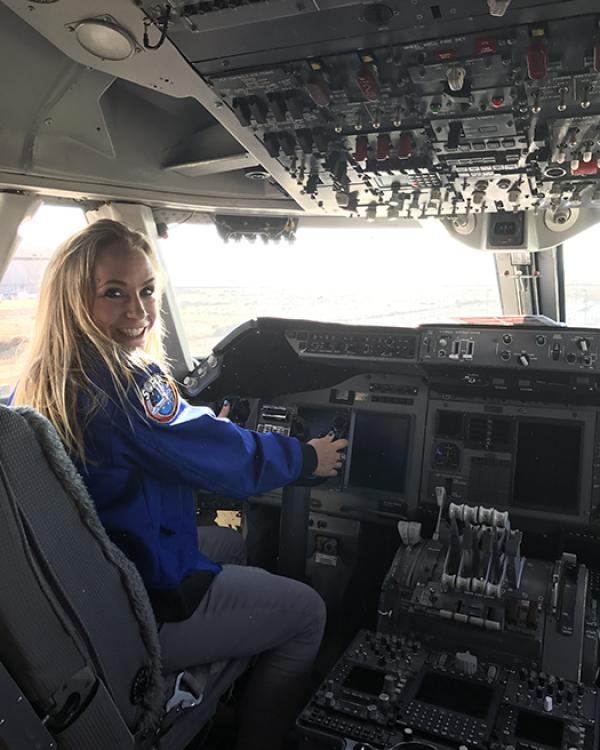
Christine Hirst Bernhardt in the cockpit of SOFIA
Christine Hirst Bernhardt, a doctoral student in Education, isn’t kidding with her email signature’s tagline “Have a Stellar Day.” Astronomy is her passion, and at the heart of her desire to learn even more about science education at the Gevirtz School. She says her earliest memory is of the Challenger Disaster, so it’s even more striking she has been part of the Teacher in Space program herself, flying on a mission of NASA’s SOFIA, the Stratospheric Observatory for Infrared Astronomy, in 2017. “That was pretty amazing,” she recalls about soaring above the water vapor and atmosphere. “That infrared telescope can unlock the secrets of the universe.”
What Bernhardt wants to do is unlock the mysteries of space for her students. That SOFIA trip had direct payoff in her classroom back on earth, for she says, “My students then were able to talk to directors and scientists at NASA. My astronomy club were the youngest authors of a NASA proposal, submitted alongside those of scientists—just sixteen and seventeen year-old kids!—and while then didn’t get it approved, that’s still amazing.” Indeed, the young woman who led that work in her class then is now an astrophysics major at UCSB.
Her love of all things astronomical goes back to childhood—she wrote an essay about Jupiter when she was seven and submitted it to Ranger Rick. “I was never encouraged that astronomy was a field to pursue,” she sadly recalls, so instead studied as a music major at Humboldt State. It wasn’t until her last few semesters that she started taking science classes and realized that was where she belonged. In 2007 she earned a secondary teaching credential in Geosciences from Cal State, Fullerton; in 2012 she earned a Master’s in Science Teacher Education from Cal State, Northridge; and then in 2016 she earned a Master’s in Space Studies from the University of North Dakota.
“That second Masters, the one in Astronomy, helped me bring really rich content to students in a field that when I was growing up I was told I couldn’t pursue,” she asserts. “It’s been pretty phenomenal.” Attending GGSE’s Department of Education was an easy choice when she decided she needed a Ph.D. “I was limited within my classroom walls to bring astronomy to the masses and wanted an even more theoretical background,” she says. “The Gevirtz School is really the only STEM education program in southern California, plus it has emphases in environment and society and global studies which seemed really pertinent to my goals.”
Those goals are far-ranging, starting with being selected as one of five members of the very first USA National Astronomy Education Coordinator team, as a part of a larger global effort from the International Astronomical Union (IAU). “This IAU opportunity came at the perfect time, as its effort to prepare a national astronomy curriculum has already been one of my goals,” Bernhardt insists. “Discovering the best ways to prepare teachers in this field is my main impetus for the Ph.D.”
When she says, “I’m taking over the world fulltime,” it’s not completely a joke. After all, her connections and experiences are worldwide, from time at the Large Millimeter Array (ALMA) in Atacama, Chile, which famously captured the image of the black hole, to helping a colleague in Thailand reorganize their science curriculum to founding a space camp in Hong Kong. “I’m empowering students and teachers to have non-standardized experiences with space as the medium,” she says. And bringing the excitement of astronomy to classrooms all over the planet.